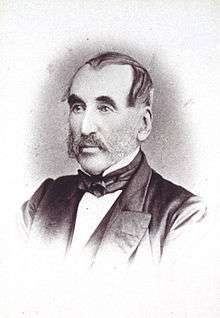Thomas Gregson
| Thomas George Gregson | |
|---|---|
 | |
| 2nd Premier of Tasmania | |
|
In office 26 February 1857 – 25 April 1857 | |
| Preceded by | William Champ |
| Succeeded by | William Weston |
| Personal details | |
| Born |
1798 Durham, England, UK |
| Died |
4 January 1874 Risdon, Tasmania |
| Nationality |
|
| Children | John Compton Gregson |
Thomas George Gregson (1798 – 4 January 1874) was the second Premier of Tasmania, serving from 26 February 1857 until 25 April 1857.
Early life
Gregson was born in Durham, England, the son of John Gregson, squire, of Lowlynn. Thomas Gregson was educated in Edinburgh and migrated to Van Diemen's Land, (later renamed Tasmania) in 1821 with his wife as a result of family differences. He brought over £3000 with him and was given a grant of 2500 acres (10 km²). Subsequently he received an additional 1000 acres (4 km²). Gregson was made a magistrate and in 1825 was assisting Andrew Bent in his conflict with Governor Arthur for the liberty of the press.
Comment
The Australian Dictionary of Biography gives the birth of Thomas George Gregson as Durham in 1798 their reference being the book written by F C Green as cited below under References. Yet according to the Northumbrian Records Office at Woodhorn, Thomas's baptism is cited in the Kyloe Baptism Register (Kyloe Parish Church) and took place on 7 February 1796. There it states that he was the son of John and Elizabeth Gregson of Buckton a village near Low Lynn. John Gregson was a kinsman of Anthony Gregson (1720-1806) the owner of the estate named Low Lynn. Anthony's son another Anthony, a bachelor, inherited Low Lynn and entailed it on Henry son of the Rev Thomas Knight of Ford, upon his death. John Gregson was not the squire of Low Lynn. (Gregson Genealogy).
Political career
In July 1842 Gregson became a member of the Tasmanian Legislative Council, and three years later led the opposition to the governor, Sir Eardley-Wilmot, in his attempt to raise the import duties. Shortly afterwards he resigned with five other members as a protest against the voting of expenditure the colony could not bear, and, among other things, the statement by the governor that he would carry the estimates by his casting vote. The six members became known as "the patriotic six" and Gregson was presented by the colonists with two thousand guineas and a piece of plate. At the end of 1850 he was elected to the new legislative council, and, when responsible government was granted, was elected a member of the Tasmanian House of Assembly for Richmond in September 1856 and held the seat for many years. On 14 February 1857 Gregson moved and carried a motion in favour of reductions in the salaries of the governor, colonial secretary, colonial treasurer and attorney-general. The William Champ ministry resigned and Gregson became premier and colonial secretary. But he was found to be unsuitable for his office; he lacked moderation, self-control and tact, and his government was defeated about eight weeks later. He was never in office again, though often a turbulent critic of other administrations. In January 1862 he was more than once committed to the custody of the sergeant-at-arms and was once expelled from the house. He retired from parliament not long before his death at Risdon on 4 January 1874. He was survived by his wife and two spinster daughters; a son John Compton Gregson (died 1867) was a Hobart barrister and attorney-general in the Gregson cabinet.
Legacy
Gregson was also an amateur artist and exhibited at the first art exhibitions held in Hobart in 1845 and 1846. He is represented in the Beattie collection at Launceston by a sketch of the Rev. Robert Knopwood on his white horse. He worked hard for the good of the colony to the neglect of his own interests for he died comparatively poor. Gregson was particularly important as a reformer in his early days, fighting for the liberty of the press, for trial by jury, and the abolishment of penal transportation.
References
- F. C. Green, 'Gregson, Thomas George (1798 - 1874)', Australian Dictionary of Biography, Volume 1, MUP, 1966, pp 475–476. Retrieved on 28 December 2008
- Serle, Percival (1949). "Gregson, Thomas George". Dictionary of Australian Biography. Sydney: Angus and Robertson. Retrieved 2008-12-28.
- Parliamentary Library profile
| Political offices | ||
|---|---|---|
| Preceded by William Champ |
Premier of Tasmania 1857 |
Succeeded by William Weston |